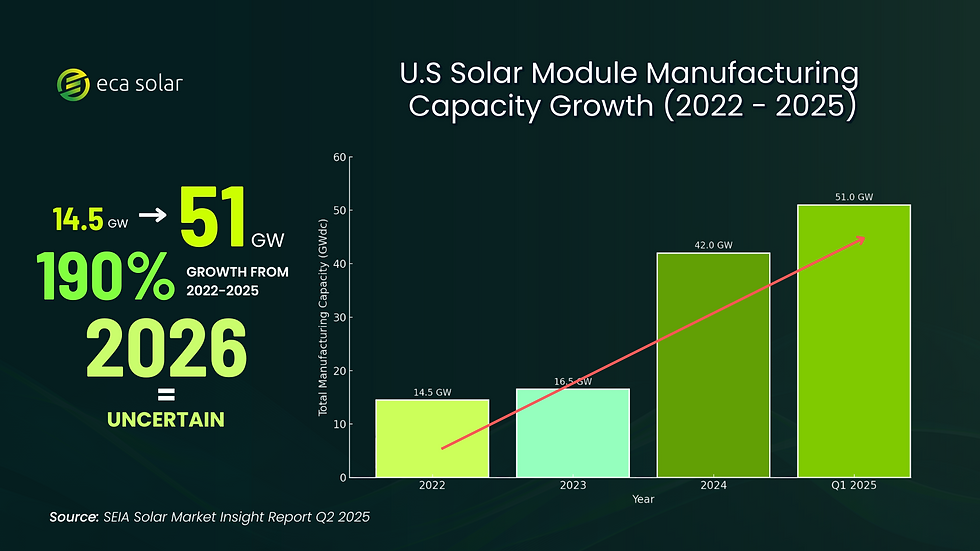Breaking Down the One Big Beautiful Bill: What Solar Developers Need to Know
- Nick Andrade
- Jul 15
- 4 min read

The signing of the One Big Beautiful Bill on July 4, 2025 marks a major shift in federal energy policy. It rolls back many of the clean energy incentives established under the Inflation Reduction Act, signaling a new era focused on domestic production, stricter sourcing rules, and reduced long-term support for renewables.
A Turning Point for U.S. Energy Policy
While credit transferability was preserved, the bill imposes tight construction deadlines and sourcing restrictions that compress development timelines and complicate financing.
Projects that begin construction by certain deadlines can avoid both the stricter sourcing requirements and a near term placed in service deadline, but on July 7, 2025 President Trump issued an executive order directing the treasury to update guidance on the beginning of construction, causing further market disruption and confusion. For commercial and utility-scale solar developers, the path forward is narrower—but still navigable with the right strategy and urgency.
What the Bill Would Change for Solar Development
For developers in the commercial and utility-scale sector, the OBBB represents a major disruption to the policy environment established under the IRA. Some key provisions of the bill include:
Sunsetting of the ITC and PTC by 2027
Under the final version of the One Big Beautiful Bill, solar projects must begin construction by July 4, 2026, or be placed into service by December 31, 2027 in order to qualify for the full 30% 48E Investment Tax Credit (ITC) or the 45Y Production Tax Credit (PTC). Projects that miss either of these deadlines will receive no federal tax incentives—the credits don’t gradually phase down like presented in the senate version; they end entirely.
This represents a dramatic shift from the framework established by the Inflation Reduction Act, which extended these credits through 2032 and allowed for more flexible qualification timelines. The new law effectively compresses a decade’s worth of development opportunity into the next 18–24 months, creating a surge of urgency across the solar sector.
In a recent video, ECA Solar CEO/Founder, Todd Fryatt breaks down what the One Big Beautiful Bill and Trump’s July 7th Executive Order mean for solar developers on the ground. From looming deadlines to domestic sourcing challenges, Todd unpacks the stakes for clean energy projects and why developers need to act now to safeguard tax credit eligibility.
Preservation of Tax Credit Transferability
Under the Inflation Reduction Act (IRA), large-scale solar developers gained a powerful tool: tax‑credit transferability, which allowed them to sell their credits to unrelated third parties for upfront capital. This effectively democratized access to solar financing—enabling smaller and midsized developers, who lacked sizable tax liabilities, to tap into financial markets previously dominated by large corporations.
Contrary to earlier drafts that would have removed this provision, the final One Big Beautiful Bill Act (OBBBA) preserves credit transferability. Eligible credits—such as the Investment Tax Credit (ITC), Production Tax Credit (PTC), and other IRA-era incentives—can still be sold to unrelated parties under Section 6418.
However, the OBBBA adds some new restrictions: credits may not be transferred to “prohibited foreign entities of concern” (PFEs) to comply with strengthened FEOC rules. Additionally, buyers of credits must pass FEOC eligibility criteria, potentially complicating transfer arrangements.
The long and short term implications for solar developers:
Financing flexibility remains intact:
Solar Developers can still monetize tax credits through sales, preserving access to upfront capital.
Added complexity and risk for projects
Enhanced due diligence is required to ensure purchasers comply with FEOC standards.
Capital market continuity:
While transferability continues, the pool of eligible buyers narrows due to FEOC constraints—potentially affecting pricing or liquidity.
Ultimately, credit transferability survives under the OBBBA, but navigating the new FEOC compliance landscape will be essential for solar developers to fully capitalize on this financing pathway.
Sourcing Restrictions on Foreign Entities
Beginning in 2026, no “specified foreign entity” or “foreign-influenced entity” can claim a 48E/45Y credit, nor can a project that receives ‘material assistance’ from a specified foreign entity. The proposed restrictions apply based on the percentage of project components by costs which are supplied by non specified foreign entities. Until new guidance is issued, taxpayers can use domestic content safe harbor tables or supplier certifications to determine the ratios. The bill also increased the clawback period for FEOC violations, from 5 years to 10 years, making it critical that all projects are verifying their supply chains.
Projects that begin construction by January 1, 2026 are not subject to the new FEOC restrictions, however President Trump’s Executive Order on July 7 will affect near term purchasing and safe harbor decisions for all developers.
ECA Solar’s Commitment Moving Forward
At ECA Solar, we are actively monitoring the legislative process and advocating for policy outcomes that support long-term, sustainable energy investment. While the One Big Beautiful Bill presents immediate challenges, we remain committed to developing impactful, community-scale and utility-scale solar solutions that drive the transition to a cleaner energy future.
Our team is working closely with partners, policymakers, and financial institutions to ensure that our projects remain viable under evolving conditions. We will continue to share updates and insights as the situation develops.




Comments